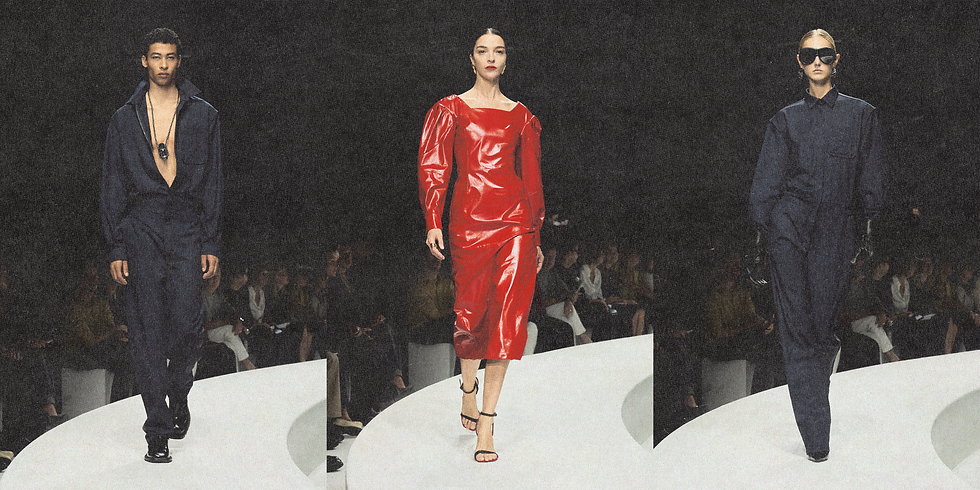Can Consumer Brands Actually Succeed on the Runway?
- Molly Elizabeth

- Oct 2, 2023
- 3 min read
The fix is clear: Lannone must position Ferrari away from wheels and instead run parallel with them — cousins, not twins.

At the heart of every brand is an intrinsic necessity to generate a distinguishable identity. This obligation may be needed nowhere more than in the strident and oversaturated fashion industry. From the creative directors and marketing executives to the CEOs and sales associates, brand identity is a primary concern. Injecting a signature offering to a desired audience often means diversifying your contributions and, for Ferrari, this has meant venturing into the high fashion enterprise. Presenting their Spring 2023 Ready-to-Wear collection against the dazzling backdrop of Milan Fashion Week, Ferrari has continued on an admirable and evergreen endeavour — keeping the Forza Ferrari spirit alive outside of simply supercars, the prancing horse, and motorsports titles.
Here’s where it all started: it’s June 2021, and Ferrari’s creative director of “brand diversification,” Rocco Lannone — of previous Dolce & Gabbana and Giorgio Armani encounters — is showing his first rendition of Ferrari: the luxury clothing company. Make no mistake; this is a newborn cut from the same cloth as its mother. Reminding audience members and potential consumers of an illustrious automobile history, Lannone chooses to show in Ferrari’s hometown of Maranello — where mechanical artisans work tirelessly to forge the ultimate motor for the uber-rich. Utilitarian, with one foot set firmly in streetwear and the other in quintessential Italian maximalism, Lannone assembles a respectable debut. It’s no 312T, but it possesses the potential of the SF-23 (in layman’s terms: it isn’t winning multiple world championship titles, but it could carry off a win here or there.)

Using the brand’s universally-recognisable IP as a recurring motif, Lannone demonstrated through further Fall and Spring cumulations his wish to “enlarge [our] fan base.” Building upon notions of speed, passion, and sheer determination, bold tones, patterns, and daring silhouettes were too intensely commonplace. Desirability, however, was notably absent.
One would be hard-pressed to uncover an automobile institution or motorsports troupe without some variety of branded merchandise on offer to consumers. What would entice a Ferrari enthusiast to squander £420 on a branded crewneck jumper comprising 82% viscose, when similar styles are obtainable via official F1 merchandise routes for a fraction of the cost? The fix is clear: Lannone must position Ferrari away from wheels and instead run parallel with them — cousins, not twins.
For Spring 2024, luxurious cohesion at last abounded. Away from the vermillion and lemon race suits that preceded, restrained innovation took the steering wheel. “Power and eroticism” are the very essence of Ferrari — noted by Lannone, now working from logical feeling and not just on-the-nose iconography. Sleek opulence was heralded in with elegant displays of white leather cropped shirts, pleated mid-length skirts, and sweeping dusters. Followed, naturally, by nods to sensual luxury in neutral tones and sheer knits — moderately revealing. A sextet of double denim takes charge before reserved navy and black take the lead in this sartorial race. Deconstructing prior race suit silhouettes proves especially triumphant in this phase, manufacturing a pragmatically stylish proposal. A somewhat random smattering of purple finally allows for Ferrari to, once again, be Ferrari in the form of bold, cherry red leather ensembles that entice, excite, and energise. Lannone has finally discovered his race-winning artistic formula — understanding the heritage of what he is nurturing while fleeing the familial nest.

Broadening a brand can prove an uneasy task, and so it is no wonder that brands place focus on collaborations in order to ingratiate themselves with a wider, often younger, audience. Mercedez-Benz and Moncler voyaged into the G-Wagon in a certainly intriguing art piece — marrying Moncler's signature puffer and the Mercedez G-class in an alliance which, in their own words, “walks the line between sculptural and multi-functional.” A decade later, Fiat 500xGucci remains a successful fashion and motor partnership. Of course, it is not just vehicular conglomerates that seek teamwork; McDonald’s was keenly aware of the possible profits at hand when they signed a license agreement with Moschino. Coca-Cola, feasibly one of this world’s most recognisable logos, joined forces earlier this year with laid-back footwear designers Brunch. The mutual relations were clear: “Coke is a leisurely staple. When you go for brunch, you have a Coke, and at Brunch, we create footwear pieces that also have that leisurely quality,” founder Daniel Sitt said of the evident alignment.
Collaborations on any scale, however, pale in comparison to an unabridged separate operation. Contracted under the Giorgio Armani Group, stationed securely in the luxury Italian market, Ferrari has taken a potentially costly gamble. At last, Lannone has unearthed a bankable artistic angle. Now, unfortunately, the real work begins. Marketing to a profit. 🌀
Molly Elizabeth is a freelance fashion writer, commentator, and media producer. She is also the founder and Editor-in-Chief of fellow online fashion publication Eternal Goddess.


